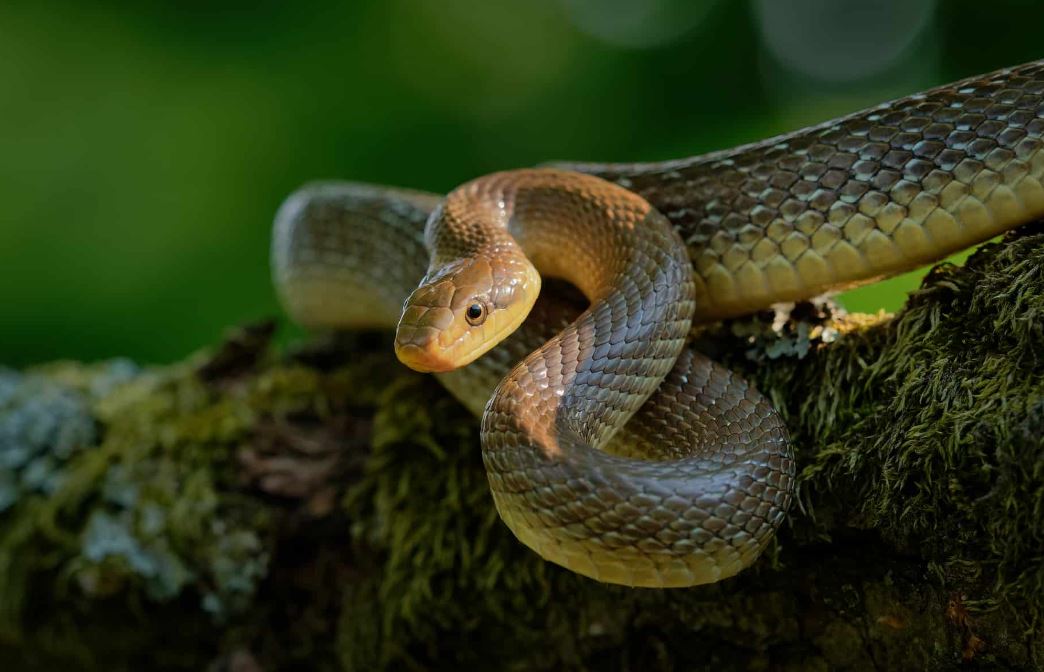List of reptiles in Britain, encompassing all indigenous reptiles found in the country. Britain is home to merely six reptile species, comprising of three snakes and three lizards. Additionally, a few non-native species have been introduced to the UK, mostly resulting from escaped pets or zoo exhibits, forming small colonies.
Moreover, British waters occasionally witness the presence of five sea turtle species (Leatherback, Loggerhead, Green, Hawksbill, Kemp’s ridley), although encounters are infrequent. (For more information about sea turtles, check out our comprehensive guide: Sea Turtles: The Complete Manual)
On this page, you will discover a comprehensive list of all reptiles in Britain, including introduced species, accompanied by captivating pictures and fascinating facts.
British Lizards
1. Common Lizard
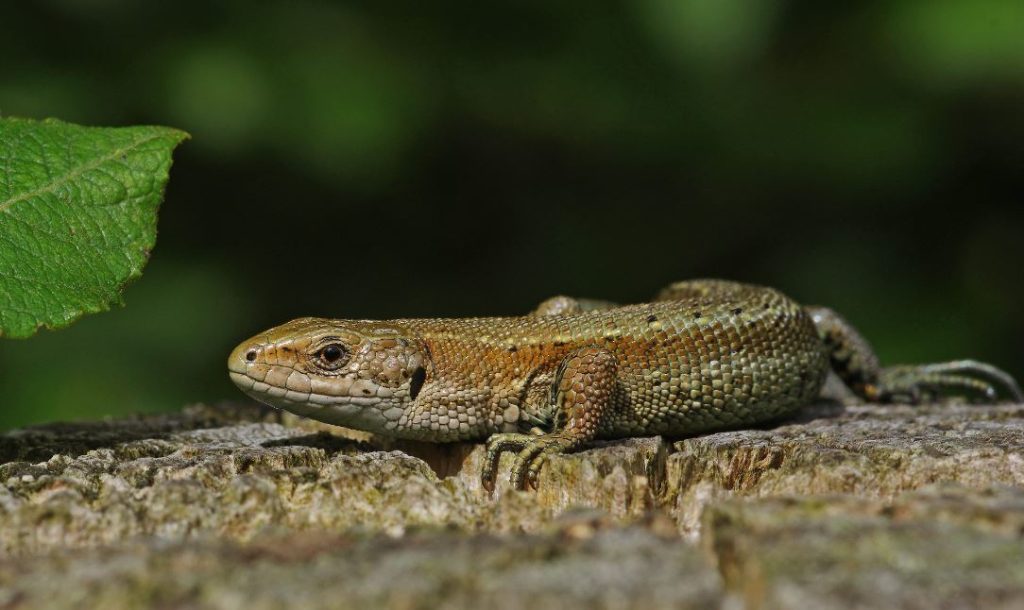
- Scientific Name: Zootoca vivipara
- International Conservation Status: Least Concern
- Habitat in Britain: Widespread across Britain and Ireland
The common lizard holds the distinction of being Britain’s most prevalent reptile. It can be found throughout the majority of Britain and is the sole reptilian inhabitant of Ireland.
This diminutive lizard exhibits a color range from grey to black, though it typically sports a mid-brown hue. Its skin features intricate patterns of lines and spots, which can either be darker or lighter than the base color. Male common lizards may display undersides that are white, yellow, or red.
Typically, the common lizard measures between 10 and 15 cm (4 and 6 inches) in length.
This adaptable species thrives in various habitats, often favoring arid environments such as heaths, moors, and proximity to sea cliffs.
In contrast to most reptiles, female common lizards give birth to live offspring instead of laying eggs. This reproductive process, known as viviparity, has earned the lizard the alternative name of viviparous lizard.
To evade predators, the common lizard possesses the ability to shed its tail. It is not uncommon to spot individuals with partial or complete tail loss.
As predators themselves, common lizards feed on insects and spiders.
2. Sand Lizard

- Scientific Name: Lacerta agilis
- International Conservation Status: Least Concern
- Habitat in Britain: Sand dunes and heathlands in southern and northwestern
England and Wales Sporting a sandy-brown hue, the sand lizard exhibits a distinct green coloration along its sides during the breeding season, particularly in males. Both genders are adorned with a series of small circular markings. The sand lizard can grow up to approximately 25 cm (10 inches) in length.
This lizard thrives in heathlands characterized by sandy soil or in sand dune environments, where it often basks under the sun. The female lays eggs in the sand.
The sand lizard is confined to a few select regions in Britain, including sandy heathlands in Dorset, Hampshire, the Hampshire-Surrey borders, as well as sand dunes in South Lancashire and Wales.
In terms of diet, sand lizards primarily consume insects and spiders.
3. Slow-Worm
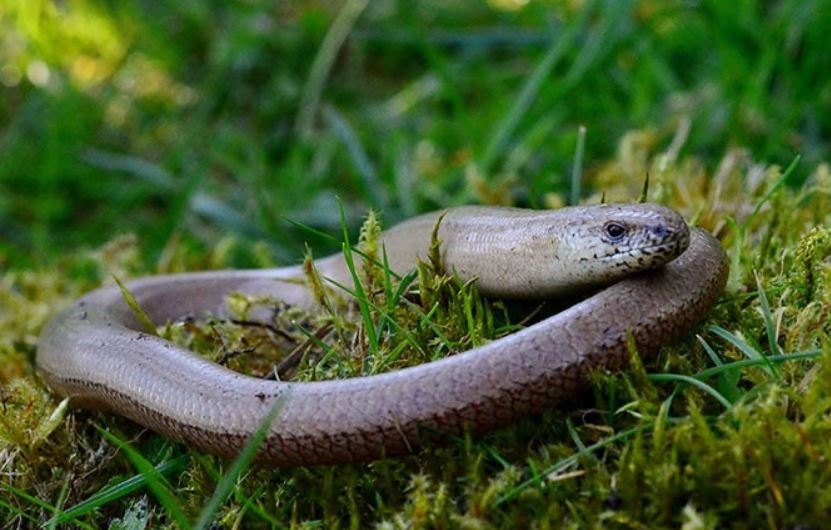
- Scientific Name: Anguis fragilis
- International Conservation Status: Least Concern
- Habitat in Britain: Found throughout most of Britain, absent from Ireland and various
Scottish islands Despite its name and snake-like appearance, the slow-worm is, in fact, a legless lizard. It exhibits a brown-grey coloration, possessing smooth and “shiny” skin with non-overlapping scales. Unlike snakes, slow-worms are capable of blinking.
Most slow-worms measure between 30 and 40 cm (11.8 and 15.7 inches) in length.
The slow-worm is commonly found in heathlands, woodland edges, hedgerows, and gardens. However, its presence is unlikely in areas where domestic cats roam, as cats are known to hunt and prey on slow-worms.
Similar to many other lizard species, slow-worms have the ability to shed their tails as a defense mechanism against predators.
During the winter months, from October to March, the slow-worm hibernates. It exhibits an ovoviviparous reproductive strategy, wherein the eggs develop and hatch internally, and the female gives birth to live young.
Remarkably, the slow-worm is one of the longest-living reptiles, with individuals documented to have lived at least 54 years in captivity and potentially up to 30 years in the wild.
4. British Snakes Adder
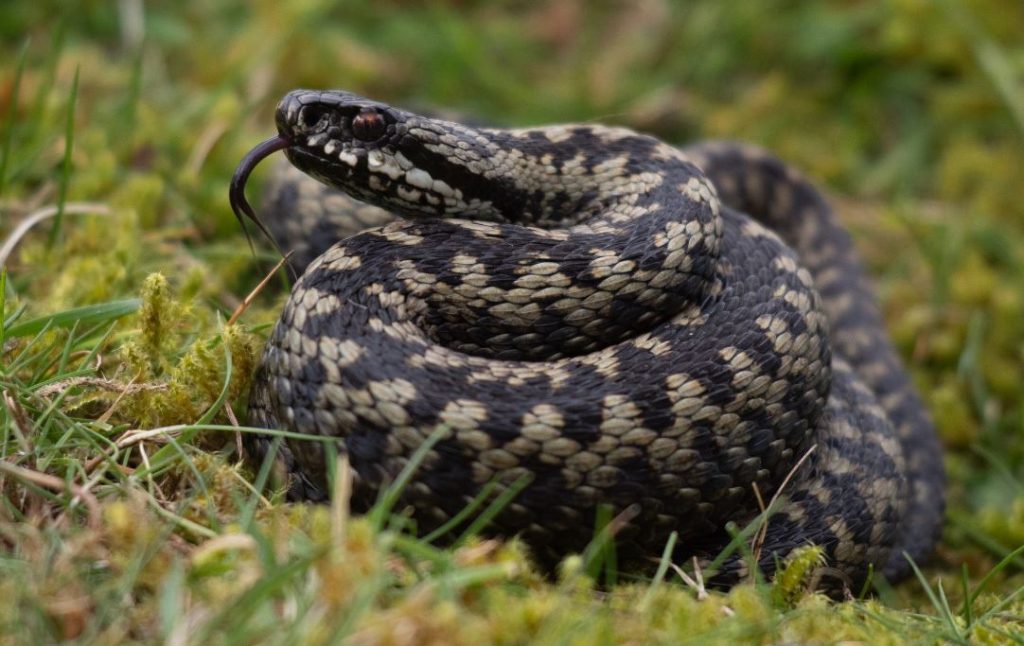
- Scientific Name: Vipera berus
- International Conservation Status: Least Concern
- Habitat in Britain: Widely distributed, but not abundant
The adder holds the distinction of being the only venomous snake native to Britain.
This snake possesses a stocky appearance and displays a grayish or pale brown coloration. Its most distinguishing feature is the zigzag pattern that runs along its back. However, individual adders may exhibit red-brown or black color variations.
While the adder can reach lengths of up to 75 cm (30 inches), most specimens are considerably smaller.
Heaths, moors, and woodland edges serve as the preferred habitats for adders. During the winter, they enter a hibernation period and are most active in spring when mating takes place.
Although an adder bite can be painful, it is typically non-lethal to healthy humans.
5. Barred Grass Snake
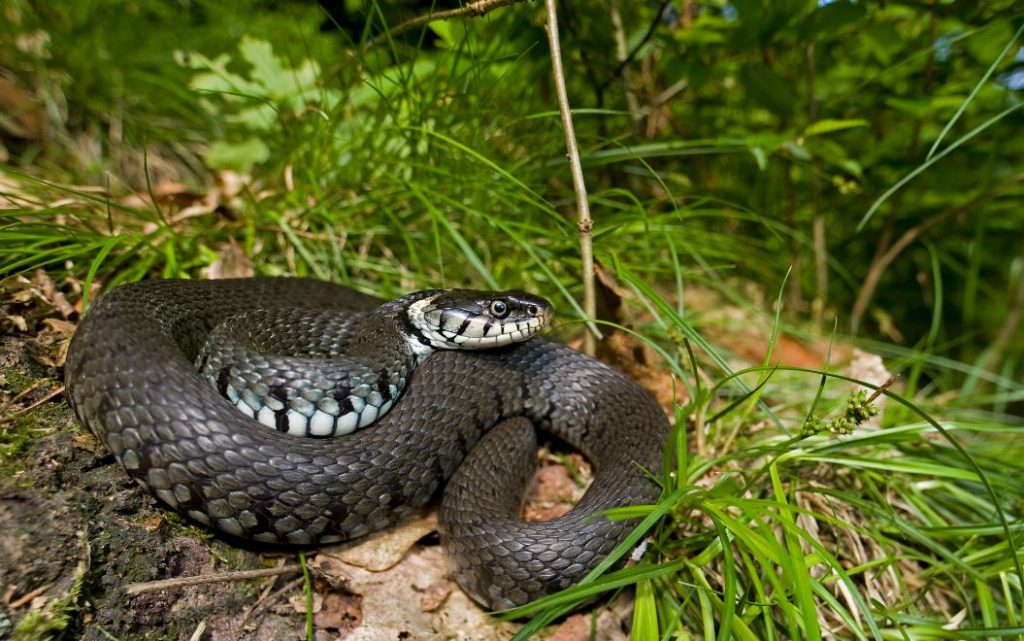
- Scientific Name: Natrix helvetica
- International Conservation Status: n/a
- Habitat in Britain: Widespread in England, Wales & Southern Scotland
Until recently, it was believed that the grass snakes in Britain were the same species as those found in Europe. However, in August 2017, scientists revealed that British grass snakes were actually a distinct species known as Natrix helvetica, or the barred grass snake, rather than the European Natrix natrix.
The barred grass snake is the largest snake species found in Britain, measuring approximately 1 meter (3.3 feet) in length from nose to tail. Its skin displays a gray or gray-green hue with dark blotches along the back and sides. It features a pale yellow collar and black markings on its neck. Compared to the grass snake, the barred grass snake appears grayer in coloration.
Grasslands and heaths, often in close proximity to water, serve as the typical habitats for the barred grass snake. It is frequently observed swimming in bodies of water.
Unlike its native counterparts, the barred grass snake is non-venomous. Its diet primarily consists of frogs and toads.
During the winter, the barred grass snake undergoes hibernation. Females lay clutches of leathery eggs in decaying vegetation and compost heaps.
6. Smooth Snake
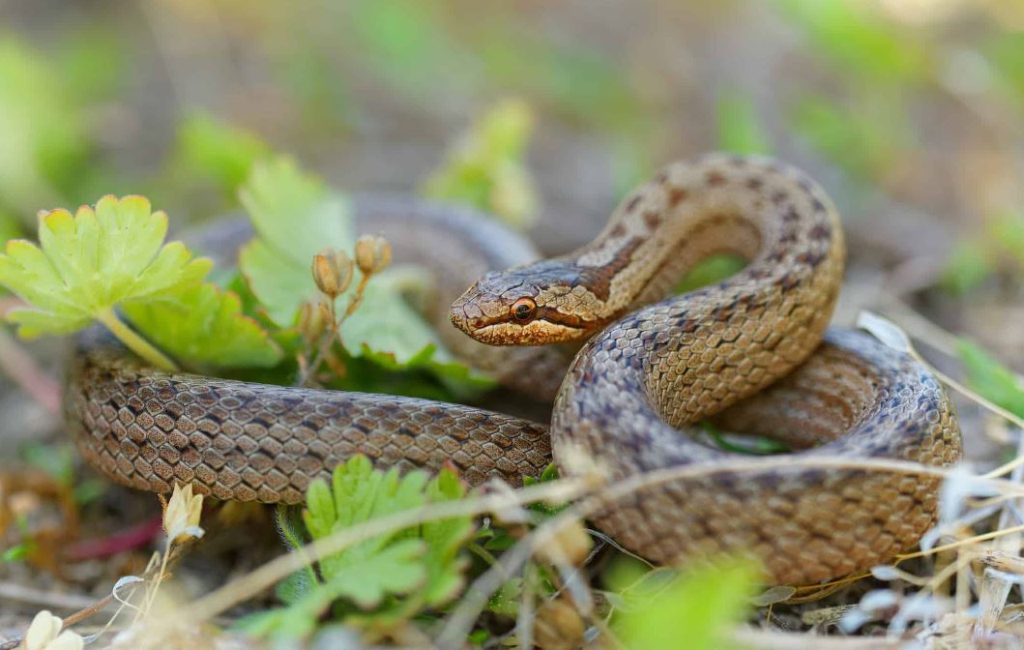
Smooth Snake, Photo by Der Irbis [CC-BY-SA-3.0]
- Scientific Name: Coronella austriaca
- International Conservation Status: Least Concern
- Habitat in Britain: Heathlands in Dorset, New Forest, N. Hampshire-Surrey borders.
Reintroduced to West Sussex and Devon. The smooth snake is the rarest reptile species in Britain. It shares similar habitat preferences with the sand lizard, including sandy heathlands and dune environments.
The smooth snake displays a brown-gray coloration. Its head is marked with a distinct dark patch that resembles a crown, while dark stripes run along each side of the head from the nostril to the neck. The snake’s back is adorned with a dark pattern.
Measuring between 50 and 60 cm (19.7 and 23.6 inches) in length, the smooth snake exhibits a slender physique and a less intricate pattern compared to the visually similar adder.
Like most reptiles, the smooth snake is non-venomous and primarily carnivorous. Its diet consists of nestlings, other reptiles such as sand lizards and slow-worms, as well as insects. When subduing larger prey, the smooth snake employs constriction by coiling itself around its victim. However, unlike true constrictors like the green anaconda and boa constrictor, the smooth snake does not kill its prey through constriction.
During the winter months, the species undergoes hibernation from October to April. The smooth snake follows an ovoviviparous reproductive strategy, giving birth to live young.
Reptiles Introduced into Britain The following species are not native to Britain and have been introduced by humans.
7. Common Wall Lizard
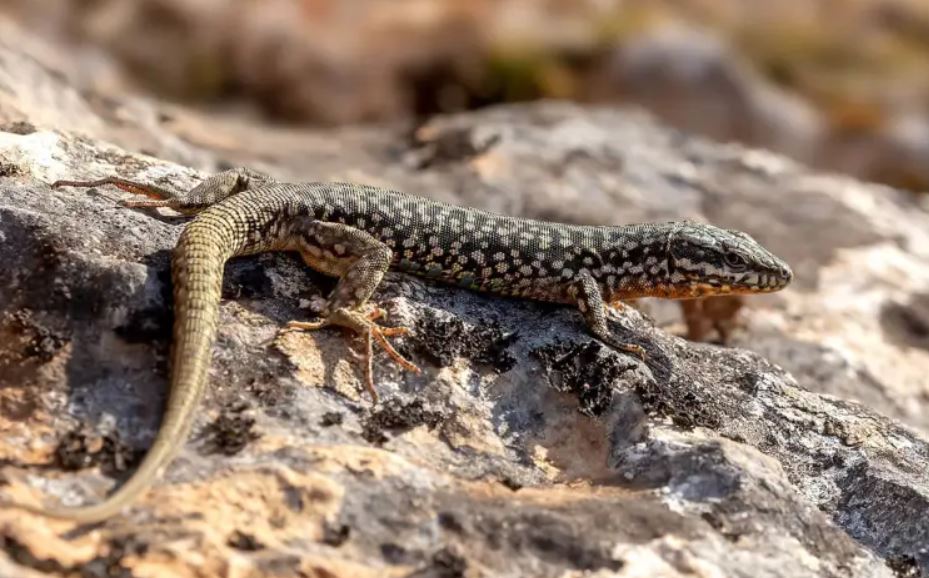
- Scientific Name: Podarcis muralis
- International Conservation Status: Least Concern
- Habitat in Britain: Southern England
The common wall lizard is a slender and small-sized lizard that exhibits a range of colors from brown to grey-green. Its markings vary, including lines and rows of spots.
The common wall lizard inhabits rocky and suburban habitats. It has been introduced to southern regions of Britain.
8. Western Green Lizard
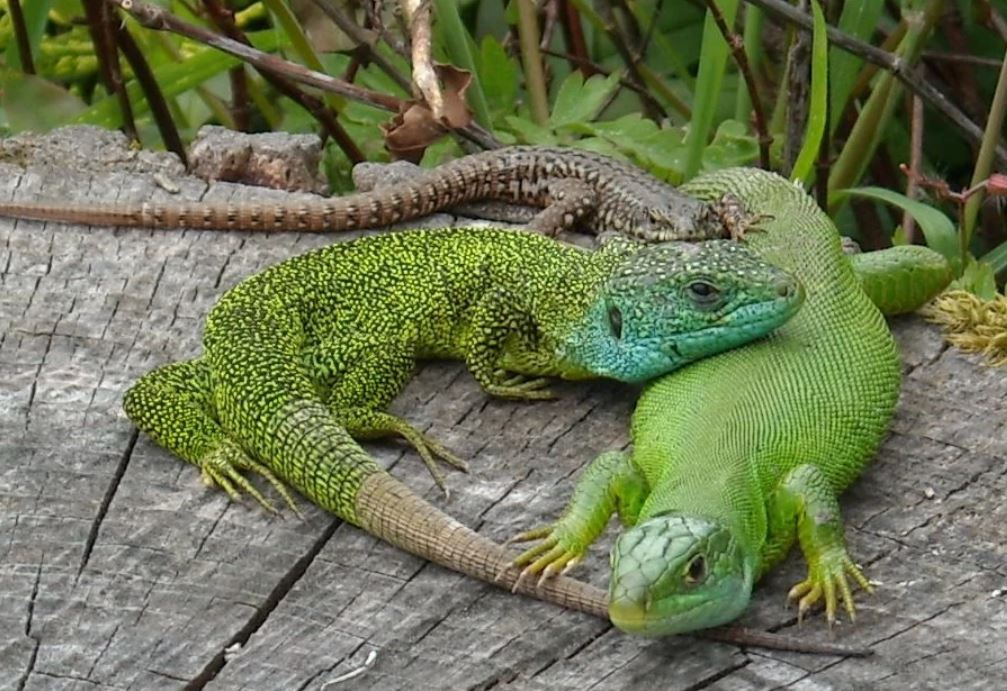
- Scientific Name: Lacerta bilineata
- International Conservation Status: Least Concern
- Habitat in Britain: Southern England, particularly Poole Bay, Dorset
The western green lizard is a vibrant green reptile that can reach lengths of up to 40 cm (15.7 inches) from nose to tail. Males often display blue throats. Woodland edges and grasslands are typical habitats for this species. An introduced population of western green lizards can be found in the heaths and cliffs of certain areas in Dorset.
9. Aesculapian Snake

- Scientific Name: Zamenis longissimus
- International Conservation Status: Least Concern
- Habitat in Britain: Conwy, North Wales; Regent’s Park, London
Two introduced colonies of the Aesculapian snake can be found in Britain. One is located near the Welsh Mountain Zoo in Conwy, North Wales, while the other is near the canal in Regent’s Park, London. Both populations are believed to have originated from escaped individuals.
The Aesculapian snake typically grows to a length of 1.6 meters (63 inches), with some individuals exceeding 2 meters (6.7 feet). It displays various colorations, including yellow-brown and green-brown, with a metallic and shiny appearance to its skin.
This non-venomous species preys on mammals, particularly rodents, as well as birds and other reptiles. Unlike native British snakes, the Aesculapian snake possesses excellent climbing abilities and may be found in trees.
